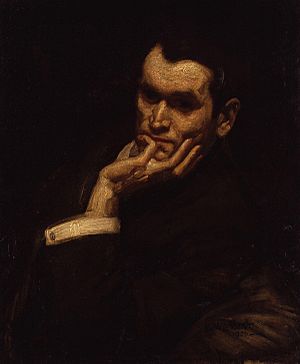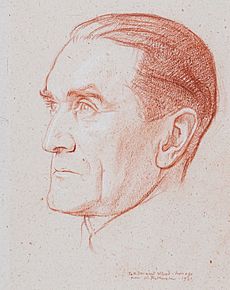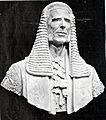Francis Derwent Wood facts for kids
Quick facts for kids
Francis Derwent Wood
|
|
|---|---|

A 1906 portrait of Wood by George Washington Lambert
|
|
| Born | 15 October 1871 Keswick, Cumbria, England
|
| Died | 19 February 1926 (aged 54) London, England
|
| Occupation | Sculptor |
| Spouse(s) | Florence Mary Schmidt (m. 1903) |
Francis Derwent Wood (born October 15, 1871 – died February 19, 1926) was a talented British sculptor. He created many beautiful statues and architectural pieces. He is especially remembered for his important work helping soldiers who were badly injured during World War I.
Contents
About Francis Derwent Wood
Early Life and Art Training
Francis Derwent Wood was born in Keswick, England. He studied art in Germany before returning to London in 1887. There, he learned from famous sculptors like Édouard Lantéri and Sir Thomas Brock. Later, he taught at the Glasgow School of Art from 1897 to 1905.
Wood made many sculptures for buildings, which was common at the time. For example, he created four large figures for the roof of the Kelvingrove Art Gallery and Museum in Glasgow. He also made sculptures for the British Linen Bank in Glasgow and Britannic House in London. You can also find his standalone sculptures in different places, like his 1907 work Atalanta, which is now in the Manchester Art Gallery.
Helping Soldiers in World War I
When World War I began, Wood was 41 years old, too old to join the army. Instead, he volunteered to help in hospitals. He saw the terrible injuries soldiers suffered from the new weapons of the war. This experience led him to open a special clinic called the Masks for Facial Disfigurement Department. It was located at the Third London General Hospital in Wandsworth.
Instead of using rubber masks, Wood created thin metal masks. He carefully sculpted each mask to look like the soldier's face before their injury. Just like how plastic surgery was helping soldiers, Wood's masks gave them new confidence and self-respect. Even though the masks could sometimes be uncomfortable, they helped hide severe face wounds. This allowed the young men to feel more comfortable returning to their families and friends.
Making each mask took many weeks of work for Wood and other surgeons who followed his method. First, they made a plaster mold of the soldier's healed face. Then, they used this mold to create a clay model of the disfigured face. The sculptor would then carefully add back the missing parts of the face, using the undamaged side as a guide. The mask itself was made from a thin sheet of copper. Painting a realistic portrait onto the copper mask was also a big challenge. Each mask was painted while the patient wore it, to perfectly match their skin tone.
This special ward was open for two years, from 1917 to 1919. We don't know the exact number of masks made, but it was likely several hundred. While this was a small number compared to the more than 20,000 soldiers with face wounds, Wood's dedicated efforts made a huge difference in the lives of those he helped.
Later Career and Notable Works
After the war, Wood became a professor of sculpture at the Royal College of Art from 1918 to 1923.
He created a sculpture in 1919 called Canada's Golgotha, which showed a crucified soldier. This artwork caused some debate between the Canadian and German governments. His Machine Gun Corps Memorial at Hyde Park Corner in London also sparked discussion.
In 1920, he was elected to the Royal Academy, a prestigious group of artists.
Personal Life
Francis Derwent Wood married Florence Mary Schmidt in 1903. He passed away in London in 1926 at the age of 55. He is buried with his wife at St Michael's Church in Amberley, West Sussex.
Selected Sculptures and Public Art
Francis Derwent Wood created many important sculptures that can be seen in public places. Here are a few examples:
- Music, Architecture, Painting, and Sculpture (1898): Four large stone sculptures on the facade of the Kelvingrove Art Gallery and Museum in Glasgow.
- Statue of Sir Titus Salt (1903): A bronze statue on a stone base in Roberts Park, Saltaire, West Yorkshire.
- Statue of General James Wolfe (1911): A bronze statue on a stone base located on The Green in Westerham, Kent.
- Canada's Golgotha (1918): A bronze relief sculpture, about 0.8 meters tall, located at the Canadian War Museum in Ottawa.
- Australia Gate (1920): Two stone statues on pillars at the approach to Buckingham Palace in London.
- Britannia (1920): An architectural sculpture on Britannic House in Finsbury Circus, London.
- War memorial (1920): A bronze effigy and panels on black marble at St Mary's Church in Ditchingham, Norfolk.
- Statue of Sir Henry Royce (1921): A bronze statue on a stone base in Riverside Gardens, Derby.
- War memorial (1922): A stone cenotaph with bronze plaques in Keswick, Cumbria.
- Machine Gun Corps Memorial (1925): A bronze statue on a pedestal with a surround, located at Hyde Park Corner, London.
- Atalanta (1929): A bronze statue on Chelsea Embankment, London. This was cast after his original marble sculpture from 1909.
Other Works
- The Penitent Thief (1918): A bronze head of one of the thieves crucified with Jesus, held at the Lady Lever Art Gallery in Port Sunlight.
- Psyche (1920): A bronze sculpture, also at the Lady Lever Art Gallery, considered a good example of the "New Sculpture" movement.
- Statue of Queen Victoria (1903): A bronze statue now in the museum at Sheesh Mahal in Patiala, India.
- Statue of Edward VII (1912): A bronze statue in the uniform of a royal field marshal, also in the museum at Sheesh Mahal in Patiala.
- Statue of Herbert Kitchener, 1st Earl Kitchener (c. 1920): A bronze statue originally in Kolkata, India, now in the courtyard of the Dhubela Museum in Madhya Pradesh.
Images for kids
-
Derwent Wood's Lord Henn-Collins
-
Derwent Wood's bust of Edward VII
See also
- Anna Coleman Ladd, another sculptor who made masks for soldiers disfigured in World War I


















